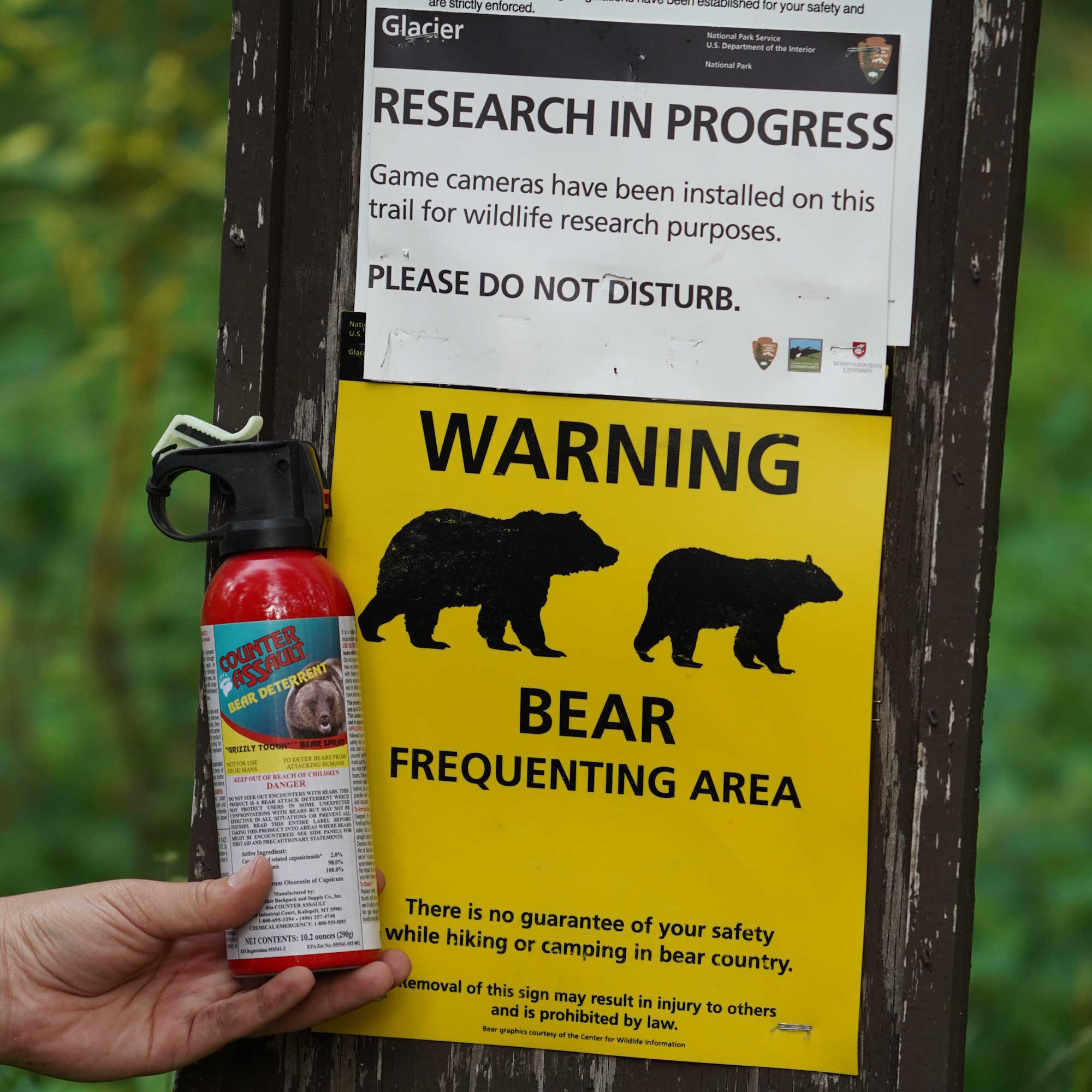Each year bears are responsible for an estimated 40 attacks on humans worldwide. In the US, this typically results in one fatal bear attack being recorded annually. The majority of attacks happen when humans are engaged in recreation, which implies that proper education for individuals who choose to enjoy the outdoors can have a positive impact on decreasing the number of encounters annually.
How Do You Tell a Black Bear from a Grizzly?
Grizzly bears are known as a more aggressive species. The black bear population in the United States is estimated to be over 750,000, making it important to understand and identify the differences between bear species.
Grizzly Bears:
-
Population estimated to be ~55k in US
-
Average Grizzly can weigh up to 600lbs
-
Range in color from black to blonde
-
Primarily located in Alaska, Wyoming, Montana, Washington, Idaho, and western Canada.
-
Uniquely humped back with long close
-
Small ears sitting atop of large head
Black Bears:
-
Population estimated to be 750,000
-
An average black bear can weigh up to 300lbs
-
Can range in colors from black to various shades of brown and in some instances appear white
-
Located in forested areas throughout the United States
-
Pointed ears with short, curved claws
Here is a map of where one can encouter grizzly and black bears in North America.

Determine the Bear's Intentions
The majority of bear attacks, regardless of species, are a result of the bear becoming defensive. This typically occurs when a bear is protecting something important to them such as their cubs, food sources or their living space or den. This is more common in natural spaces when humans are recreating in bear country.
In some instances, bears can become predatory. It occurs when bears have been introduced to unnatural food sources such as trash or poorly stored food or waste. This encourages bears to enter areas that are populated by humans and will encourage them to be more present in places that is not natural to them.
While the two species may be different in appearance, both show similar signs when becoming aggressive or predatory. Noticing these signs in advance can provide valuable time in taking action to protect yourself from what could become a dangerous situation. Some signs to be aware of include:
-
Ears appearing to be pinned back
-
Open mouth appearing to be yawning
-
Jaw popping
-
Being increasingly vocal with growing or making other huffing noises
-
Bluff charging
-
Stalking or circling
-
Focusing on prey
-
Sudden bursts of speed in movement
Steps to Survive the Attack

While avoiding a bear attack should be a priority, there is a reason most outdoor adventurers say “hope for the best, but plan for the worst.” Bear attacks, while rare, do occur. Being prepared with the right skills could save your life if you encounter an aggressive bear. Whether a bear is attacking you, or a member of your group, being prepared should be a definite priority. This may seem simple in theory. However, knowing how to apply these skills in a real situation could mean the difference between life and death.
Stay Calm and Don’t Run
While the natural urge when faced with a charging bear is to panic, staying calm and standing your ground can be extremely beneficial. Running may trigger an instinct in the bear to chase you if it has become defensive or predatory. Plus, you cannot outrun bears who are known to reach speeds of up to 35 mph (Usain Bolt’s running at his peak velocity was just 28 mph).
Remaining calm and standing your ground is your first step to attempting to deter the bear from making physical contact.
Make Noise and Talk to The Bear
Bears can be scared by loud noises and voices if they recognize them as human. Being loud, talking, or yelling, “hey bear,” can often be a useful line of defense for deterring an attacking bear. Often, this will allow a bear to realize you are a human, which will often scare them away. Some other impactful ways to make noise that could scare a bear away are:
-
Banging on a pot or pan
-
Playing loud music
-
Honking a horn on a vehicle
Make yourself and children seem BIG!
Bear’s prey is typically smaller in size than they are. If you make yourself seem bigger than you are by raising your hands, standing up, a bear will become more intimidated by you. This applies especially to children. Typically smaller in stature, get your children off the ground. Picking your children up off the ground will not only make them seem bigger but will also make yourself seem bigger, further deterring a bear from attacking. Do this while continuing to make as much noise as possible to deter the bear from moving closer.
Don’t React, and Stand your Ground!
Bluff charges are common ways for bears to determine the level of threat they are facing. Often, if faced with a charge, a bear will become more inclined to attack if you react in a way that makes you seem less dominant. Standing your ground and continuing to make noise to ensure the bear sees you as a threat will often deter a bear from continuing their charge.
Use your Bear Spray!
If the bear continues to move in your direction, this is the time to use your Counter Assault bear spray. This is the best option once a bear gets within striking range, often within 60 feet. Aiming your bear spray directly at the bear’s face and mouth will create a mist that is your most effective way to safely deter a bear from continuing towards you.
The Counter Assault 10.2 oz bear spray has a range effective up to 40 feet, so discharging at this time will create a defense barrier between you and the bear that likely will cause a bear to flee.
Once the bear flees from you, move in the direction opposite of the bear to increase the space between you and the animal. Make sure to keep your bear spray readily available in the chance a subsequent encounter occurs.
After taking these steps, the bear will hopefully be deterred enough for your group to safely retreat from the area. However, in some circumstances the bear may continue to attack. If this occurs, your next steps are related to the type of bear you are faced with.
Steps to Take If an Attack Continues
Grizzly/Brown Bear
Play dead! Grizzly and brown bears tend to attack only in situations where they feel threatened. By playing dead, you can reduce the likelihood of the bear feeling threatened, and encourage the animal to wander away. How do you do that?
-
Lie down
-
Tuck your needs to your chest
-
Cover your head and neck
Black Bears
Fight back! Black bears are less deterred by playing dead. So fighting back can be your final line of defence if the attack continues. You can:
-
throw rocks or other objects at the bear
-
attempt to hit them in the eye, face or nose if the animal is too close
Fighting back can stun the bear and encourage them to flee.
Using Bear Spray

Using bear spray can be an effective way to deter a charging or approaching bear. When carrying bear spray, use a holster of your choosing, typically on your waist, chest, backpack or belt. If faced with a situation where using your bear spray is necessary, follow these steps:
-
To arm, remove the safety clip
-
Point in the direction of the charging bear, and squeeze the trigger.
-
To disarm, put the safety clip back onto the trigger in the same fashion and push in until the clicks stop.
Counter Assault bear spray is an effective choice to utilize due to its 40ft spray distance and proprietary mixture that ensures it will be effective up to its expiration date.
How Common are Bear Attacks in the US
Bear attacks are uncommon. However, the more time you spend on outdoor trails, the higher your chances of encountering a bear. Globally, there are 40 recorded bear attacks each year. Inside of this, there are some interesting statistics that apply specifically to North America, such as:
-
Between 2000-2015 there were 183 bear attacks in North America
-
Each year, there is 1 death due to bear attack in the US
While bears can attack in any region where bears are present, there are definitely areas where attacks occur more frequently. Some hotspots where bear attacks become more prevalent are:
-
Glacier National Park - Montana, USA
-
Yellowstone National Park - Wyoming, USA
-
Bridger-Teton National Forest - Wyoming, USA
-
Shoshone National Forest - Wyoming, USA
-
Algonquin Provincial Park - Ontario, Canada
In North America, the bulk of attacks occur in the US, with 62% of occurrences, with attacks in Canada coming in at 38%. While National Parks and Forests are by far the leading areas where attacks may occur, this should not take away the importance of being prepared any time you are heading out on the trails in regions where bears are present.
Outside of location, the likelihood of a bear attack occurring can also be pinned to a time of year. Most outdoor adventurers are generally aware of the fact that bears hibernate during the winter, there can be important trends to recognize at different times of the year.
May-October are generally peak season for bear attacks, with the highest frequency of occurrences falling typically in August. If you venture outdoors during the summer in North America, you should be prepared and carry your bear spray with you regardless of where in bear country you go.
In summary, while bear attacks may be fairly uncommon, there is no replacement for being fully informed and prepared for the worst case scenario. To start, when faced with a bear encounter, you should first be able to acknowledge the type of bear you are dealing with - specifically if this is a grizzly/brown bear or a black bear. This will allow you to better adjust your steps in protecting yourself if an attack occurs. With this knowledge and some Counter Assault Bear Spray, you can rest assured you will be prepared to take action if needed.














